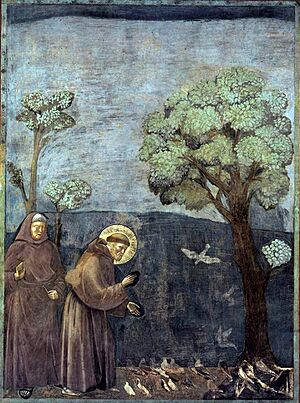Duecento facts for kids

The Duecento is what people call the 13th century in Italy. This Italian word means "two hundred," but it refers to the 1200s. It was a very important time for Italian culture, just before the famous Renaissance period began.
What Was the Duecento Like?
The Duecento is seen as the century right before the Italian Renaissance started. The Renaissance was a huge cultural movement that really took off in the next century, called the Trecento. Sometimes, the Duecento is even called the Early Proto-Renaissance because it laid the groundwork for what was to come.
One of the most important places for art and buildings during this time was Florence. Florence was a powerful city in Italy, important for its politics, economy, and culture. Other key cities were Pisa, Siena, Arezzo, Mantua, and Perugia. All these cities are in the region of Tuscany.
During the Duecento, Italy also saw the rise of a special kind of music called Trovatori music. A famous musician from this time was Sordello of Mantua. This music helped shape the classical music that became popular during the Italian Renaissance.
Many important people lived during this century:
- Dante Alighieri is often called the "father" of the Italian language. He wrote famous poems.
- Giotto di Bondone was an Italian painter and architect from Florence. Many people think he was the first of the great artists who led to famous figures like Leonardo da Vinci and Michelangelo in the later Renaissance.
- Guittone d'Arezzo and Guido da Siena were also important artists.
- Nicola Pisano and Arnolfo di Cambio were famous for their sculptures and buildings.
The religious figure of Saint Francis of Assisi was also very important to many Italians during the Duecento. His poem Canticle of the Sun is considered an early example of Renaissance poetry.
See also
 In Spanish: Duecento para niños
In Spanish: Duecento para niños
Images for kids
-
Mongol Emperor Genghis Khan whose conquests created the largest contiguous empire in history
-
A page of the Italian Fibonacci's Liber Abaci from the Biblioteca Nazionale di Firenze showing the Fibonacci sequence with the position in the sequence labeled in Roman numerals and the value in Arabic-Hindu numerals.
-
Portrait of the Chinese Zen Buddhist Wuzhun Shifan, painted in 1238, Song dynasty.
-
The opening page of one of Ibn al-Nafis' medical works. This is probably a copy made in India during the 17th or 18th century.
-
Hommage of Edward I (kneeling), to the Philippe le Bel (seated). As duke of Aquitaine, Edward was a vassal to the French king.
-
Alai Gate and Qutub Minar were built during the Mamluk and Khalji dynasties of the Delhi Sultanate.







